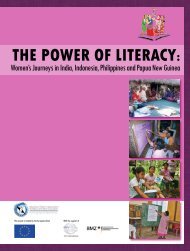Gender Discrimination in Education: The violation of rights of women ...
Gender Discrimination in Education: The violation of rights of women ...
Gender Discrimination in Education: The violation of rights of women ...
Create successful ePaper yourself
Turn your PDF publications into a flip-book with our unique Google optimized e-Paper software.
PART III: Necessary state action<br />
a girl, because young <strong>women</strong> suffer<br />
physical development and can face<br />
discrim<strong>in</strong>ation <strong>in</strong> some jobs.”<br />
Girl, 17 years old, urban Bolivia<br />
21. <strong>The</strong> responsibility for address<strong>in</strong>g gender<br />
discrim<strong>in</strong>ation <strong>in</strong> education – as understood through<br />
the 4A framework – lies ultimately with States. <strong>Gender</strong><br />
<strong>in</strong>equalities <strong>in</strong> education are a function <strong>of</strong> gender<br />
discrim<strong>in</strong>ation and patriarchal social and cultural<br />
structures, which exist everywhere <strong>in</strong> the world. Yet<br />
any government can revolutionize girls’ and <strong>women</strong>’s<br />
experience <strong>of</strong> the education system through adopt<strong>in</strong>g<br />
laws, policies and practices to make education available,<br />
accessible, acceptable and adaptable. Bangladesh, despite<br />
the existence <strong>of</strong> ongo<strong>in</strong>g challenges, has achieved gender<br />
parity for primary and secondary enrolment and for<br />
primary completion via policies <strong>in</strong>clud<strong>in</strong>g free secondary<br />
education for girls, improved school construction,<br />
<strong>in</strong>clud<strong>in</strong>g <strong>of</strong> sanitary facilities, and targets for <strong>in</strong>creased<br />
recruitment <strong>of</strong> female teachers xvii .<br />
22. Given the scarce resources available and broader<br />
social gender <strong>in</strong>equalities, national strategies should<br />
focus pr<strong>in</strong>cipally on governance and budget<strong>in</strong>g.<br />
Governance reforms should address themselves to the<br />
question <strong>of</strong> who creates, implements and monitors<br />
policies, as well as how the authorities are held<br />
accountable. Women and girls – <strong>in</strong>clud<strong>in</strong>g the most<br />
marg<strong>in</strong>alized – must participate <strong>in</strong> governance if the<br />
system is to function <strong>in</strong> their <strong>in</strong>terests. Similarly, genderresponsive<br />
budget<strong>in</strong>g and decision mak<strong>in</strong>g that <strong>in</strong>cludes<br />
civil society participation is widely understood to have<br />
a significant impact <strong>in</strong> improv<strong>in</strong>g education for girls xviii .<br />
GCE’s analysis <strong>of</strong> education availability shows that high<br />
performance <strong>in</strong> access is clearly l<strong>in</strong>ked to <strong>in</strong>creases <strong>in</strong><br />
education and related development spend<strong>in</strong>g.<br />
9<br />
<strong>Gender</strong> <strong>Discrim<strong>in</strong>ation</strong> <strong>in</strong> <strong>Education</strong>: <strong>The</strong> <strong>violation</strong> <strong>of</strong> <strong>rights</strong> <strong>of</strong> <strong>women</strong> and girls
















